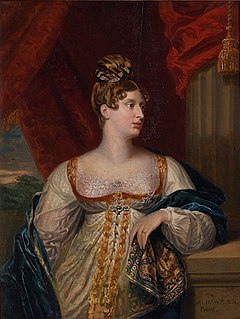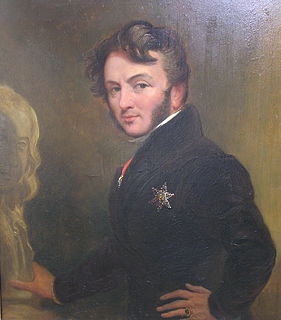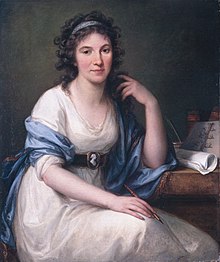
Caroline of Brunswick-Wolfenbüttel was Queen of the United Kingdom and Hanover from 29 January 1820 until her death in 1821, being the estranged wife of King George IV. She was Princess of Wales from 1795 to 1820.

Princess Augusta of Saxe-Gotha-Altenburg was Princess of Wales by marriage to Frederick, Prince of Wales, son and heir of King George II. She never became queen consort, as Frederick predeceased his father in 1751. Augusta's eldest son succeeded her father-in-law as King George III in 1760. After her spouse died, Augusta was presumptive regent of Great Britain in the event of a regency until her son reached majority in 1756.

Princess Charlotte Augusta of Wales was the only child of George, Prince of Wales, and his wife, Caroline of Brunswick. Had she outlived both her grandfather George III and her father, she would have become Queen of the United Kingdom, but she died in childbirth at the age of 21, predeceasing them both.

Dame Emma Hamilton, generally known as Lady Hamilton, was an English maid, model, dancer and actress. She began her career in London's demi-monde, becoming the mistress of a series of wealthy men, culminating in the naval hero Lord Nelson, and was the favourite model of the portrait artist George Romney.

Prince Augustus Frederick, Duke of Sussex, was the sixth son and ninth child of King George III and his queen consort, Charlotte of Mecklenburg-Strelitz. He was the only surviving son of George III who did not pursue an army or navy career. He was known for his liberal views, which included reform of Parliament, abolition of the slave trade, Catholic Emancipation, and the removal of existing civil restrictions on Jews and Dissenters.

The History of Rasselas, Prince of Abissinia, originally titled The Prince of Abissinia: A Tale, though often abbreviated to Rasselas, is an apologue about bliss and ignorance by Samuel Johnson. The book's original working title was "The Choice of Life". The book was first published in April 1759 in England. Early readers considered Rasselas to be a work of philosophical and practical importance and critics often remark on the difficulty of classifying it as a novel.

Charlotte, Princess Royal, was Queen of Württemberg as the wife of King Frederick I. She was the eldest daughter and fourth child of King George III of the United Kingdom and his wife, Charlotte of Mecklenburg-Strelitz.

Vice-Admiral Sir Thomas Masterman Hardy, 1st Baronet, GCB was a Royal Navy officer. He took part in the Battle of Cape St. Vincent in February 1797, the Battle of the Nile in August 1798 and the Battle of Copenhagen in April 1801 during the French Revolutionary Wars. He served as flag captain to Admiral Lord Nelson, and commanded HMS Victory at the Battle of Trafalgar in October 1805 during the Napoleonic Wars. Nelson was shot as he paced the decks with Hardy, and as he lay dying, Nelson's famous remark of "Kiss me, Hardy" was directed at him. Hardy went on to become First Naval Lord in November 1830 and in that capacity refused to become a Member of Parliament and encouraged the introduction of steam warships.

Sir William Hamilton,, was a British diplomat, antiquarian, archaeologist and vulcanologist. After a short period as a Member of Parliament, he served as British Ambassador to the Kingdom of Naples from 1764 to 1800. He studied the volcanoes Vesuvius and Etna, becoming a Fellow of the Royal Society and recipient of the Copley Medal. His second wife was Emma Hamilton, famed as Horatio Nelson's mistress.

Sir George Hayter was a notable English painter, specialising in portraits and large works involving in some cases several hundred individual portraits. Queen Victoria appreciated his merits and appointed Hayter her Principal Painter in Ordinary and also awarded him a Knighthood 1841.

Louisa Frederica Augusta Cavendish, Duchess of Devonshire, formerly Louisa Montagu, Duchess of Manchester, was a German-born British aristocrat sometimes referred to as the "Double Duchess" due to her marriages, firstly to the 7th Duke of Manchester and then to the 8th Duke of Devonshire.

Princess Augusta Sophia of the United Kingdom was the sixth child and second daughter of King George III and Queen Charlotte.

Thomas William Coke, 2nd Earl of Leicester, known as Viscount Coke from 1837 to 1842, was a British peer.

Princess Augusta Frederica of Great Britain was a British princess, granddaughter of King George II and the only elder sibling of King George III. She was Duchess of Brunswick-Wolfenbuttel by marriage to Charles William Ferdinand, Duke of Brunswick. Her daughter Caroline was the spouse of King George IV.

Frances Villiers, Countess of Jersey was a British Lady of the Bedchamber, one of the more notorious of the many mistresses of King George IV when he was Prince of Wales, "a scintillating society woman, a heady mix of charm, beauty, and sarcasm".

White Lodge is a Grade I listed Georgian house situated in Richmond Park, in the London Borough of Richmond upon Thames. Formerly a royal residence, it now houses the Royal Ballet Lower School, instructing students aged 11–16.

St George's Chapel at Windsor Castle in England is a castle chapel built in the late-medieval Perpendicular Gothic style. It is both a Royal Peculiar and the Chapel of the Order of the Garter. St George's Chapel was founded in the 14th century by King Edward III and extensively enlarged in the late 15th century. It is located in the Lower Ward of the castle. The castle has belonged to the monarchy for almost 1000 years and was a principal residence of Elizabeth II before her death. The chapel has been the scene of many royal services, weddings and burials — in the 19th century, St George's Chapel and the nearby Frogmore Gardens superseded Westminster Abbey as the chosen burial place for the British royal family.The running of the chapel is the responsibility of the dean and canons of Windsor who make up the College of St. George. They are assisted by a Clerk, Verger and other staff. The Society of the Friends of St George's and Descendants of the Knights of the Garter, a registered charity, was established in 1931 to assist the college in maintaining the chapel.

Emma Hamilton is a 1968 historical drama film directed by Christian-Jaque and starring Michèle Mercier, Richard Johnson and John Mills. It was partly based on the 1864 novel La Sanfelice by Alexandre Dumas and depicts the love affair between Emma Hamilton and Horatio Nelson. It was a co-production between Italy, West Germany, France and the United States.

Lady Anne Hamilton was a courtier and writer, and friend of the uncrowned British Queen Caroline of Brunswick.
Queen Charlotte's Cottage is an 18th-century cottage orné within the grounds of Kew Gardens on the banks of the River Thames in London. It is named after Queen Charlotte, who was responsible for its construction. Dating from 1772, the cottage is Grade II* listed. The cottage is maintained by Historic Royal Palaces, and is open to visitors.



















